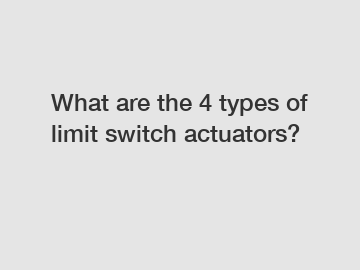What are the 4 types of limit switch actuators?
Limit switches are indispensable components in industrial automation systems, providing precision and reliability in monitoring and controlling mechanical motion. These devices utilize various actuator types to detect and signal changes in physical parameters. In this blog, we delve into the world of limit switch actuators, exploring the four distinctive types and their applications.
1. Lever Actuators:
Lever actuators are among the most common and simplest types used in limit switches. They consist of a lever arm that pivots at one end and activates the switch contacts at the other end. Lever actuators offer versatility and are available in different configurations to suit varying installation requirements. Their ease of adjustment allows for precise control over actuation points, ensuring accuracy in applications such as end-of-travel detection and position sensing.

2. Roller Actuators:
Designed for applications that require linear or radial sensing, roller actuators employ a rotating wheel or roller. As the actuator moves, a cam on the wheel actuates the switch contacts. This type of actuator is highly effective in detecting objects with irregular shapes or surfaces. Roller actuators are often used in conveyor belts, packaging systems, and other applications where reliable and consistent sensing is crucial despite uneven surfaces or changing conditions.
3. Plunger Actuators:
Plunger actuators, as the name suggests, utilize a spring-loaded plunger that directly actuates the switch contacts. This actuator type enables momentary or momentary-to-maintain switch operation. Plungers may have roller or rod tips, providing options for different functionality. With their robust design, plunger actuators can sustain high shock or vibration environments, making them ideal for heavy-duty applications. These can include machine tool clamps, doors and gates, and safety interlocks.
4. Sealed Actuators:
When operating conditions demand enhanced protection against dust, water, or other contaminants, sealed actuators are the preferred choice. Sealed actuators encompass a range of designs, including lever, roller, and plunger actuators, each with added sealing features. These actuators are typically encased in durable housings with robust sealing mechanisms, safeguarding internal components from external elements. Sealed actuators find extensive applications in industries such as food and beverage, pharmaceuticals, and marine environments.
Conclusion:
Understanding the four types of limit switch actuators empowers engineers and system integrators to select the most suitable option based on the specific requirements of their applications. Lever actuators offer versatility, roller actuators excel in detecting irregular surfaces, plunger actuators provide durability in challenging environments, and sealed actuators offer robust protection against external elements. By considering factors like sensing range, actuation force, and environmental conditions, professionals can optimize their automation systems with the appropriate limit switch actuator type.
Remember, the effectiveness of a limit switch greatly depends on proper installation, regular maintenance, and adherence to safety standards. Consulting product manuals and seeking expert advice from manufacturers can provide additional insight into your specific application needs. Empower your operations and embrace the advantages of limit switch actuators that bring reliability, safety, and efficiency to your industrial automation systems.
The company is the world’s best Sealed Limit Switch, Limit Switch Company, Long Lever Micro Switch supplier. We are your one-stop shop for all needs. Our staff are highly-specialized and will help you find the product you need.

Comments
0